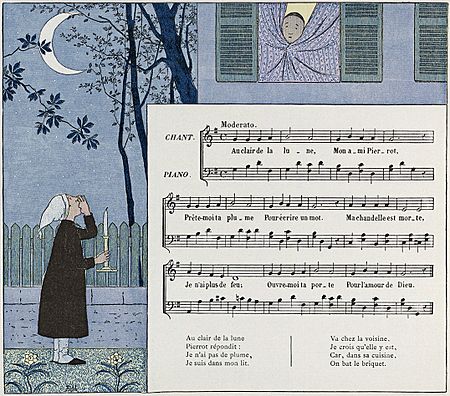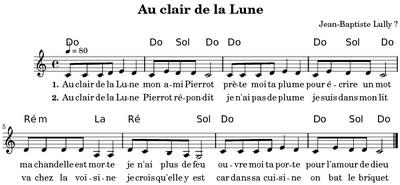Au clair de la lune facts for kids
"Au clair de la lune" (which means "By the Light of the Moon" in French) is a very old French folk song. It was created in the 1700s. We don't know who wrote the music or the words. Its simple tune is often used to teach people how to play musical instruments.
Contents
Lyrics and Story
The song tells a short story about a person who needs help. They go to their friend Pierrot's house late at night.
|
"Au clair de la lune, |
"By the light of the moon, |
Some people believe that the word "plume" (meaning "pen" or "quill") was originally "lume." "Lume" was an old word for "light" or "lamp." This would change the meaning of the song slightly.
The Song in Music
Many famous musicians have used "Au clair de la lune" in their own works.
Classical Music
- In the 1800s, French composer Camille Saint-Saëns used the first few notes of the song. He put them in a part called "The Fossils" in his famous music piece The Carnival of the Animals.
- Another French composer, Ferdinand Hérold, wrote a set of piano pieces based on the song.
- Claude Debussy, who wrote the famous "Clair de lune" (a different piece), also used "Au clair de la lune" in his song "Pierrot."
- Erik Satie included this song in his 1914 piano collection called Sports et divertissements.
- In 1926, Samuel Barber created a new version of the old folk tune. He did this while he was studying music.
- In 1928, Marc Blitzstein made an orchestral version of "Variations on 'Au Claire de la Lune'."
Modern Recordings
- In 1964, French pop singer France Gall recorded her own version of the song. She changed the words to make it a love song.
- In 2008, something very cool happened! Researchers in America turned an old paper recording into sound. This recording was made by Édouard-Léon Scott de Martinville on April 9, 1860. It was a short part of "Au clair de la lune." Many people said this was the earliest known recording of a human voice and music! The recording starts with "Au clair de la lune, mon ami Pierrot, prête moi."
- Also in 2008, composer Fred Momotenko wrote a piece called "Au clair de la lune." It was inspired by that very old 1860 recording. This piece is for a four-part vocal group and surround sound. It won prizes in music competitions.
The Song in Art
In 1804, an artist named Pierre-Auguste Vafflard showed a painting. It showed a man named Edward Young burying his daughter at night.
Someone who saw the painting wrote a poem about it. The poem used words similar to "Au clair de la lune" to describe the painting's dark colors.
|
Au clair de la lune |
By the light of the moon |
The Song in Books
The song has also appeared in different books and stories.
- In 1835, a story called "Story of my Friend Peterkin and the Moon" mentioned the song many times. The story ended by saying how everyone in Paris sang "Au clair de la lune" every night. It reminded them of the kind neighbor and the friend who wouldn't open his door.
- In his 1952 book Witness, Whittaker Chambers remembered his mother singing the song to his brother. He said he didn't like the sad part of the song. He thought it was about a little girl who was cold and asked a little boy for help, but he said no. This seemed mean to him.
- In the 1957 play Bad Seed, a character named Rhoda is seen practicing "Au Clair de la Lune" on the piano.
See also
 In Spanish: Au clair de la lune para niños
In Spanish: Au clair de la lune para niños




